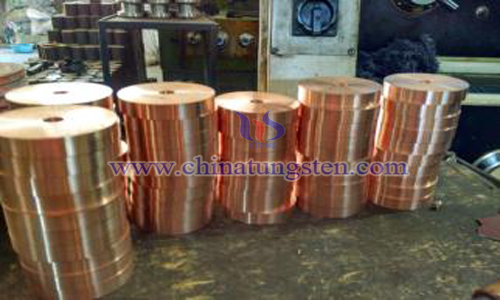Tungsten-Molybdenum-Copper Composite Alloy Preparation by Spark Plasma Sintering
- Details
- Category: Tungsten Information
- Published on Sunday, 25 August 2019 12:45
Tungsten-copper or molybdenum-copper alloys are composites consisting of two-phase mixtures that neither dissolve with each other nor form intermetallic compounds. Tungsten and copper have good arc erosion resistance, weldability, high strength and high hardness. They are widely used in electronic, electrical, military equipment, aviation, aerospace and other new technology fields.

At present, tungsten-molybdenum copper-infiltrated materials are mainly prepared by traditional infiltration method in China, that is, tungsten-molybdenum skeleton is prepared at high temperature, and then tungsten-molybdenum-copper composite alloy are prepared by high temperature copper-infiltration. This method has some shortcomings, such as high sintering temperature, long sintering time and serious grain growth. Moreover, these complicated processes increase the production process, increase the difficulty of production and increase the production cost, thus limiting the popularization and application of W-Mo-Cu composites to a certain extent.
In order to break through the bottleneck of infiltration method, some scholars used spark plasma sintering to prepare W-Mo-Cu composite alloy. The specific process steps and conditions of this method are as follows:
1.First, 10-70wt%W, 10-70wt%Mo and 10-40wt%Cu powder are added into stainless steel ball grinding dishes in high-energy planetary ball mill, then the ball milling speed is 100-200r/min, and the ball milling time is 2-12 hours. At the same time, a little alcohol is added into the ball grinding dishes to prevent the powder from being oxidized in the process of ball milling.
2. Loose powder of tungsten, molybdenum and copper mixed by ball milling is loaded into graphite mould, and then controllable pulse current (400-2000A) is added to the mould. The sintering process is realized by adjusting the magnitude of pulse current and controlling the heating rate. Under the condition of vacuum less than 10-3 pa, the graphite mould should be heated at a heating rate of 50-150 ℃/min to 200 ℃ for 1-5 min, then heated at a heating rate of 50-150 ℃/min to 750-1050 ℃ for further heat preservation. Before sintering temperature is reached, a small pre-pressure P1 (10-30 MPa) should be applied to the graphite mould. When the temperature rises up to 100 ℃/min, the graphite mould should be heated at a lower pre-pressure P1 (10-30 MPa). The tungsten-molybdenum-copper alloy was obtained by freezing the structure of W-Mo-Cu alloy at 750-1050 ℃, then applying pressure P2 (20-40 MPa) and holding for 3-20 minutes.
Compared with the existing melt infiltration method, the spark plasma sintering method can reduce the preparation temperature from 1100 to 1600 degrees Celsius to 750 to 1050 degrees Celsius, and shorten the preparation time from 100 to 760 minutes to 15 to 45 minutes. The energy consumption of the spark plasma sintering method is only 1/3 to 1/2 of the traditional sintering process. Tungsten-molybdenum-copper composites can be prepared without the second thermal process of preparing tungsten-molybdenum skeleton first and then copper infiltration at high temperature. This greatly simplifies the production process, shortens the preparation cycle, further saves the production cost and improves the working conditions of the preparation environment.
- Tungsten Alloy Manufacturer & Supplier, Chinatungsten Online: www.tungsten-alloy.com
- Tungsten News & Prices of China Tungsten Industry Association: www.ctia.com.cn
- Molybdenum News & Price: news.molybdenum.com.cn
- Tel.: 86 592 5129696; Fax: 86 592 5129797; Email: sales@chinatungsten.com



 sales@chinatungsten.com
sales@chinatungsten.com